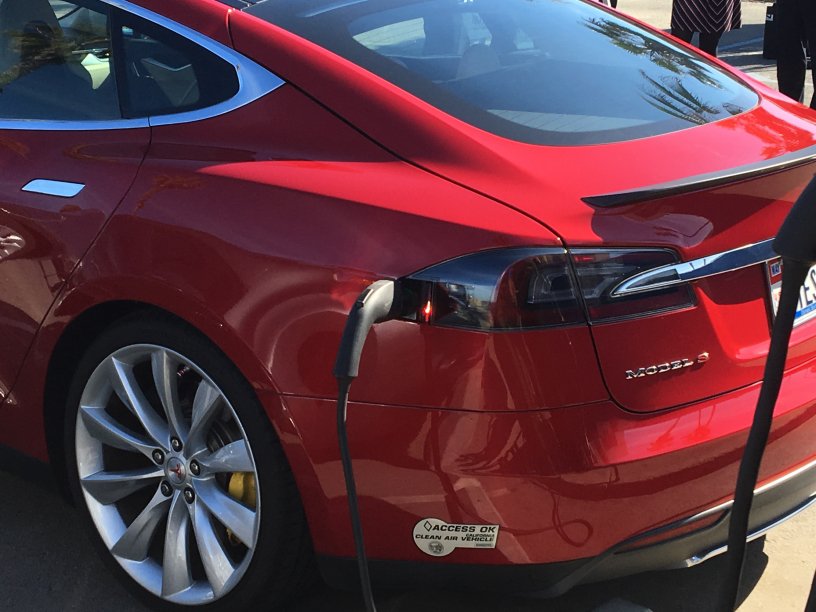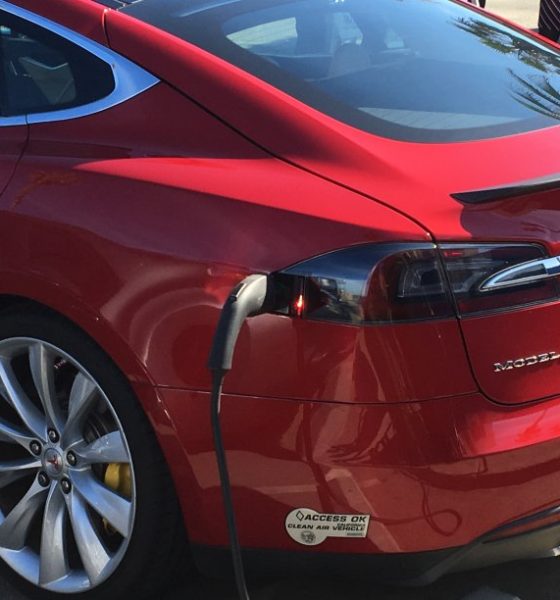

News
VW prepares to spend first $300M of $2B on EV charging infrastructure project
Volkswagen will designate $300 million by 2019 to establish a network of more than 450 electric vehicle charging stations in 11 U.S. major metropolitan areas and along high traffic highways. The announcement came this week through Volkswagen’s new wholly owned subsidiary called Electrify America, which will support increased use of zero emissions vehicles (ZEVs) in the U.S.
The initiative is part of the Federal Trade Commission agreement with Volkswagen to compensate for “Dieselgate,” the systematic and willful deceit of U.S. emissions regulators through special software in Volkswagen’s diesel vehicles. Electrify America is a product of Volkswagen’s 2016 court settlement with the California Air Resources Board and the U.S. EPA. We recently reported that the VW emissions scandal has given life to a new generation of electric vehicle start ups like Rivian Automotive. The Illinois-based electric car company has leased land to a logistics company that’s using the space as a temporary holding area for the Dieselgate VWs. Teslarati commissioned a videographer to capture drone shots showing roughly 14,000 affected cars waiting to be disposed of as a result of the scandal.

Thousands of VW Diesels being Stored at Rivian Factory, Photo: Jim Finch for Teslarati
Electrify America will support and promote greater availability of customer-friendly infrastructure in areas with high demand for ZEVs. With hundreds of stations with non-proprietary chargers across the U.S., Electrify America‘s first National ZEV investment cycle will make it easier and faster for millions of Americans to charge their electric vehicles while also “encouraging more drivers to explore and embrace electric driving.”
Electrify America‘s first stage plans
Electrify America has released information through a press release and website that it will establish a network of 2,500+ non-proprietary electric vehicle chargers at more than 450 station sites.
- Approximately 240 charging station sites will be installed or under development outside of California by the end of the first cycle.
- These sites will be located along high-traffic corridors between metropolitan areas, including multiple cross country routes.
- They will include between four and ten 150 kW and 320 kW individual DC fast chargers at each location.
- Charging sites will be present in 39 U.S. states.
- They will be built along corridors with a high correlation with the EV Charging Corridors recently designated by the Federal government.
- Sites will be, on average, about 66 miles apart, with no more than 120 miles between stations.
Comparisons to Tesla’s Supercharger network
The extent and speed of Electrify America‘s planned installation schedule roughly parallels the early years of Tesla’s DC Supercharger network in the U.S., which began in late 2012.
The new Electrify America chargers will be non-proprietary. Tesla vehicles use a proprietary plug design, although the company sells compatible adapters. Tesla’s DC CHAdeMO adapter is limited to 50 kilowatts of power.
With proposed charging power set at 320 kilowatts, the Electrify America network would be the first high power contender, at scale, to the Tesla Supercharger network. Tesla is the only EV manufacturer right now capable of charging vehicles at up to 120 kW, which equates to about 170 miles of range in as little as 30 minutes. Tesla has built a fast DC Supercharger network that supports maximum theoretical charging rates of up to 145 kilowatts, according to the company’s website.
The Electrify America network will provide 2500+ chargers at more than 450 stations. At this writing, Tesla Superchargers are at over 2,200 charging stalls at 350 locations across the U.S.
The proximity of Electrify America‘s chargers along frequently traveled corridors means that many shorter range ZEVs available today will be able to use this network. Most Tesla sites are located along highways away from large metropolitan areas and are primarily intended for use by travelers on long-distance trips.
It seems likely that the Electrify America chargers will be located in existing public infrastructure like rest stops. Tesla has a growing network of Destination Charging Partners with dedicated Tesla Wall Connectors at their properties. The company’s website describes how these are primarily destinations where a Tesla owner would stay for several hours at a time, such as ski resorts, restaurants, hotels and others. They are safe, well-lit, and infuse a feeling of security when Tesla owners need to recharge their vehicles.
Electrify America stations will be designed to support many existing and anticipated charging technology needs, including evolving industry standards like the Combined Charging Standard (CCS) and the Open Charge Point Protocol. Last year, Tesla joined the European CharIN consortium that is leading the development of CCS.
Tesla reminds its owners that there are many factors that affect the actual charge rate, including ambient temperature, utility grid restrictions, and charging traffic. Tesla constantly incorporates owner feedback into its maintenance and research and development efforts, offering a distinct consumer experience for Tesla owners who use its Superchargers.

News
Tesla FSD fleet is nearing 7 billion total miles, including 2.5 billion city miles
As can be seen on Tesla’s official FSD webpage, vehicles equipped with the system have now navigated over 6.99 billion miles.

Tesla’s Full Self-Driving (Supervised) fleet is closing in on almost 7 billion total miles driven, as per data posted by the company on its official FSD webpage.
These figures hint at the massive scale of data fueling Tesla’s rapid FSD improvements, which have been quite notable as of late.
FSD mileage milestones
As can be seen on Tesla’s official FSD webpage, vehicles equipped with the system have now navigated over 6.99 billion miles. Tesla owner and avid FSD tester Whole Mars Catalog also shared a screenshot indicating that from the nearly 7 billion miles traveled by the FSD fleet, more than 2.5 billion miles were driven inside cities.
City miles are particularly valuable for complex urban scenarios like unprotected turns, pedestrian interactions, and traffic lights. This is also the difference-maker for FSD, as only complex solutions, such as Waymo’s self-driving taxis, operate similarly on inner-city streets. And even then, incidents such as the San Francisco blackouts have proven challenging for sensor-rich vehicles like Waymos.
Tesla’s data edge
Tesla has a number of advantages in the autonomous vehicle sector, one of which is the size of its fleet and the number of vehicles training FSD on real-world roads. Tesla’s nearly 7 billion FSD miles then allow the company to roll out updates that make its vehicles behave like they are being driven by experienced drivers, even if they are operating on their own.
So notable are Tesla’s improvements to FSD that NVIDIA Director of Robotics Jim Fan, after experiencing FSD v14, noted that the system is the first AI that passes what he described as a “Physical Turing Test.”
“Despite knowing exactly how robot learning works, I still find it magical watching the steering wheel turn by itself. First it feels surreal, next it becomes routine. Then, like the smartphone, taking it away actively hurts. This is how humanity gets rewired and glued to god-like technologies,” Fan wrote in a post on X.
News
Tesla starts showing how FSD will change lives in Europe
Local officials tested the system on narrow country roads and were impressed by FSD’s smooth, human-like driving, with some calling the service a game-changer for everyday life in areas that are far from urban centers.

Tesla has launched Europe’s first public shuttle service using Full Self-Driving (Supervised) in the rural Eifelkreis Bitburg-Prüm region of Germany, demonstrating how the technology can restore independence and mobility for people who struggle with limited transport options.
Local officials tested the system on narrow country roads and were impressed by FSD’s smooth, human-like driving, with some calling the service a game-changer for everyday life in areas that are far from urban centers.
Officials see real impact on rural residents
Arzfeld Mayor Johannes Kuhl and District Administrator Andreas Kruppert personally tested the Tesla shuttle service. This allowed them to see just how well FSD navigated winding lanes and rural roads confidently. Kruppert said, “Autonomous driving sounds like science fiction to many, but we simply see here that it works totally well in rural regions too.” Kuhl, for his part, also noted that FSD “feels like a very experienced driver.”
The pilot complements the area’s “Citizen Bus” program, which provides on-demand rides for elderly residents who can no longer drive themselves. Tesla Europe shared a video of a demonstration of the service, highlighting how FSD gives people their freedom back, even in places where public transport is not as prevalent.
What the Ministry for Economic Affairs and Transport says
Rhineland-Palatinate’s Minister Daniela Schmitt supported the project, praising the collaboration that made this “first of its kind in Europe” possible. As per the ministry, the rural rollout for the service shows FSD’s potential beyond major cities, and it delivers tangible benefits like grocery runs, doctor visits, and social connections for isolated residents.
“Reliable and flexible mobility is especially vital in rural areas. With the launch of a shuttle service using self-driving vehicles (FSD supervised) by Tesla in the Eifelkreis Bitburg-Prüm, an innovative pilot project is now getting underway that complements local community bus services. It is the first project of its kind in Europe.
“The result is a real gain for rural mobility: greater accessibility, more flexibility and tangible benefits for everyday life. A strong signal for innovation, cooperation and future-oriented mobility beyond urban centers,” the ministry wrote in a LinkedIn post.
News
Tesla China quietly posts Robotaxi-related job listing
Tesla China is currently seeking a Low Voltage Electrical Engineer to work on circuit board design for the company’s autonomous vehicles.

Tesla has posted a new job listing in Shanghai explicitly tied to its Robotaxi program, fueling speculation that the company is preparing to launch its dedicated autonomous ride-hailing service in China.
As noted in the listing, Tesla China is currently seeking a Low Voltage Electrical Engineer to work on circuit board design for the company’s autonomous vehicles.
Robotaxi-specific role
The listing, which was shared on social media platform X by industry watcher @tslaming, suggested that Tesla China is looking to fill the role urgently. The job listing itself specifically mentions that the person hired for the role will be working on the Low Voltage Hardware team, which would design the circuit boards that would serve as the nervous system of the Robotaxi.
Key tasks for the role, as indicated in the job listing, include collaboration with PCB layout, firmware, mechanical, program management, and validation teams, among other responsibilities. The role is based in Shanghai.
China Robotaxi launch
China represents a massive potential market for robotaxis, with its dense urban centers and supportive policies in select cities. Tesla has limited permission to roll out FSD in the country, though despite this, its vehicles have been hailed as among the best in the market when it comes to autonomous features. So far, at least, it appears that China supports Tesla’s FSD and Robotaxi rollout.
This was hinted at in November, when Tesla brought the Cybercab to the 8th China International Import Expo (CIIE) in Shanghai, marking the first time that the autonomous two-seater was brought to the Asia-Pacific region. The vehicle, despite not having a release date in China, received a significant amount of interest among the event’s attendees.








